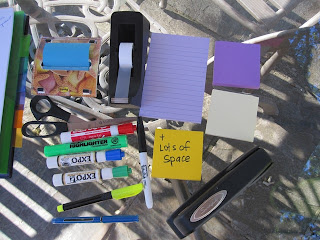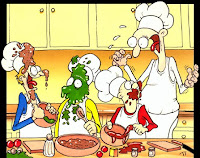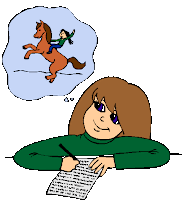- Think critically
- Communicate effectively
- Collaborate
- Create and innovate
No matter where you go, conversations about the Common Core dominate. While educators are at all levels of understanding the Common Core, there seems to be one question that everybody is asking: What will it mean to my instruction?
Some doomsayers have declared the end of the Reading Workshop asserting that the goals of the Common Core do not align with this approach. I would argue that nothing could be further from the truth. As a document, the Common Core dictates “what all students are expected to know and be able to do, not how teachers should teach.” And as a way of teaching, I believe that the components and practices inherent in the reading workshop are not only a well-founded methodology for approaching implementation of the Common Core, but probably our best option for effective implementation of the new standards.
To illustrate why this is true, let’s look at the first anchor standard for reading:
Read closely to determine what the text says explicitly and to make logical inferences from it; cite specific textual evidence when writing or speaking to support conclusions from the text. Read closely to determine what the text says explicitly and to make logical inferences from it; cite specific textual evidence when writing or speaking to support conclusions from the text.
When I look at a standard like that and ask myself, what will I need to do to be in compliance, I can see that children will require an understanding of inferential thinking. They will need to understand how to go back into the text and find evidence to support their thinking. How will I help students unpack these heady concepts? By providing explicit, focused instruction. What is the best way I know to provide this kind of instruction? Mini lessons.
While mini lessons are the cornerstone of the reading workshop, they are but one aspect of the reading workshop. The standard goes on to specify that students cite specific textual evidence when writing or speaking to support conclusions from the text. This implies that our instruction build in opportunities to write in response to reading. The reading response journal is another key ingredient of the reading workshop. Very often, we have students “Stop and jot” so that they can experience what it means to respond and have an opinion about text. On other occasions, we have them write extended responses as a way of developing and defending their positions. Both offer students opportunities to practice drawing conclusions, using evidence from the text, and afford us the rare glimpse into children’s thinking processes that enable us to respond to where they are as learners and plan instruction that meets their needs as readers.
In addition, this standard asks for students to be able to defend their position when speaking. This implies that students will require ample opportunity to speak with their peers to develop their ideas. How do we do this in reading workshop? Through partnerships where students turn and talk and eventually, when students learn to talk effectively, we release children into literature circles and allow them to develop theories and ideas that will shape and change their thinking about text, and subsequently, the world.
Another thing that I want to point out about reading workshop and the common core is this: The Common Core calls for all students “to be able to read grade level complex text.” I have encountered many teachers who have latched onto “close reading” as the means for making children increasingly capable of reading grade level complex text. While I agree that we do need to instill a value for rereading, I whole-heartedly disagree with how some teachers have proposed meeting this challenge: Handing out a short passage on Monday, reading it, talking about it, putting it away and taking it out again on Tuesday, Wednesday, Thursday, and Friday for the purpose of rereading it and getting something new out of it. The goal of close reading is deep understanding and careful analysis. That is achieved through purposeful rereading and accountable conversation. Once again, these components are built into the reading workshop.
People who are “college and career ready” have been described as being able to do the following four things:
I fear that loose interpretations of the Common Core will lead to people embracing bad practices which will do nothing to help our cause of helping children become more proficient readers so that they are college and career ready.
However, if we are thoughtful about what needs to happen so that children can read increasingly complex text and gain the knowledge that helps them to solve complex problems in the workplace, we will see that children will need to read widely, they will need to read a lot, they will require explicit, expert instruction in whole groups, small groups, and one-on-one, they will need to talk and write about their ideas and where do all of these things happen? In a reading workshop.
In my opinion, reading workshop should be on the radar in every school district across the United States. Not only does it provide a good possibility for meeting the standards of the Common Core, it offers the best possibility of being successful.
Assigning Reading Comprehension vs. Teaching Reading Comprehension
When it comes to comprehension instruction, we have data that says that we spend as little as 2% of our instructional time teaching children how to make meaning. (Lanning, 11) What we tend to do instead is give students a passage like this:
Some fire is a natural part of the life of a forest. Fire cleans out dead brush by burning it to ash. Then animals that live in the forest can find food more easily. New plants and trees have more room and sunlight to grow.
(From Fires and Floods by Kate Waters, p 11)
And ask questions like:
What is this passage mostly about:
What is this passage mostly about:
- How fires destroy forests
- How fires can be helpful
- How fires help animals
- How fires clear away dead brush
And when children respond anything but answer 2, we conclude that this student does not understand main idea.
However, foregone conclusions like this are not particularly helpful in helping us make decisions about how to correct the problem. We are left wringing our hands, wrought with worry over what will happen come April when these students take the ELA. We know we need to fix the problem but we are all left wondering the same thing: How?
The sample question that you see above actually came from a group of six fourth grade students working together to figure out the main idea of the paragraph about fire. This group of children had received explicit instruction on what a main idea is and how identifying main idea helps readers monitor text for meaning. Next they took a look at this paragraph and worked with partners to figure out what it was mostly about. As they did that, the teacher listened closely and took notes about what they said and discovered that sometimes children were too broad and general when identifying the main idea. In other cases, she recognized that students were too specific and pulled details from the story and dubbed them “the main idea.” And in yet other instances, children relied solely on their background knowledge about the topic to identify the main idea.
The small group structure allowed the teacher a rare glimpse into the otherwise invisible process of making meaning. In returning to the original dilemma of knowing that there’s a problem but feeling stuck knowing what to do about it, this glimpse provided the answer to the original question of HOW to fix the main idea problem: Responsive small group strategy instruction. If we are to effectively raise children’s reading proficiency, creating situations where children are active participants in their learning is imperative. We must listen closely to clues they provide about their learning processes and then work with the diligence of Sherlock Holmes to solve the mystery of what is standing in the way of growth. In the end, good assignments don’t make children better readers but good teaching…wow! What a difference that can make!
Lanning, Lois A. 4 Powerful Strategies for StrugglingReaders, Grades 3-8: Small Group Instruction That Improves Comprehension. Thousand Oaks, CA: Corwin, 2009. Print. (Amazon affiliate link)
The Blame Game
Yesterday I checked in to the Hilton in Rye Brook, New York for the New York State Reading Association’s annual conference. When I arrived, I checked in at the front desk and then proceeded to lug a duffle filled with clothes, a suitcase of AV equipment, and a couple of errant bags through the elevator and maze of hallways to finally arrive at my room. Ready to lighten my load, I eagerly took out my key card and stuck it in the door.
The yellow light in the middle lit up.
Desperate for a green light that signaled entrée into my room, I took the card out, and put it in again.
Again, a yellow light. So I tried a third time.
While famous for my technological ineptitude, I figured after three failed tries, the problem wasn’t me. So I loaded up all my stuff and headed back down the hall to find a phone to call the front desk.
A short while later, a man in official looking hotel attire showed up to let me into my room. We exchanged niceties and viola, I was in! Let the conference begin!
After trolling the exhibit hall and greeting colleagues whom I haven’t seen in a long while, I returned once again to my room to freshen up for dinner. When I arrived, I put my key in the door and guess what?
Yellow light.
Fortunately this time my roommate was there to let me in. She had two keys that seemed to work so I took one and once again, my key issue seemed to be resolved.
I left the room, checked to make sure that the key would let me back in and joined friends and colleagues for a lovely dinner with the folks from Scholastic. When I returned at nearly 11:00 PM, I put my key in the door and need I even say?
Yellow light.
I trekked down the hall once again to the community phone and called the front desk and this time they sent security. When the hotel representative arrived, he took my key and looked at it, then he looked at me, and then he tried sticking it in the door. Yellow light.
At that point, he turned to me and said, “When you left the room, did you slam the door?”
I couldn’t believe it. Was he insinuating that it was my fault the door didn’t work? I explained that this was the third time today that this had happened and that generally I don’t slam doors when I leave rooms.
Then he inserted his specially programmed, ultra powerful, get into any room key card and unlocked my door. He jiggled the lock on the other side and said, “See, this wasn’t all the way over, that’s why you couldn’t unlock the door.”
As I got to thinking about this incident, it made me think a lot about teaching. My son told me last week that he asked a teacher a question and was told, “You should have been paying attention.” In the same way that the security man made me feel responsible for the problem, my son’s teacher made him feel the same way. When children have questions, it could be because they weren’t paying attention but it could also be that the directions weren’t clear or the child is not an auditory learner and can’t picture what the teacher is talking about. No matter what the case, if there is a problem, we need to quickly assess and evaluate and troubleshoot to solve it. To take the extra step to blame or pass the buck is just that: an extra step. It is neither efficient nor EFFECTIVE.
I’m old enough and experienced enough to know that if I have another problem with my door, I will continue to seek the help I need to fix it. But I wonder about my son. The next time he has a question, will he ask it? Or, will he blame himself and stay stuck?
Deeply Reading a Diorama
On Sunday, I took my children to the American Museum of Natural History in New York City. As we wandered the halls of the Asian Peoples exhibit, my eight year old son stopped to peer at a diorama of an ancient group of Syberian people. As I looked over his shoulder at tiny little figures pulling a whale on a handcrafted sleigh and another group of men pointing swords at a wolf, he exclaimed, “That’s cool!” I was excited that he was excited but I wanted to know more, I wanted him to know more, so I asked him, “What is this about?”
I can bet any amount of money that you know what he said when I asked this question because his response was the knee jerk answer to probing questions that we hear from children on a daily basis: “I don’t know.”
I prompted him to look again and this time, to look closely at the diorama in small chunks. He began by peering at the whale being hauled on the sleigh. His first musing was that the whale was hurt but after some consideration, he decided that the men had gone hunting and that this would be their food. He guessed that the whale was very, very heavy because there were five men pulling it. He guessed, too, that it must be very cold there because the men were wearing heavy parkas and boots.
After looking at this section of the diorama he moved on to the wolf. I wondered out loud if the wolf was a religious symbol in this culture because in the center of the diorama was a large pole with two wolves hanging. My son quickly discounted this theory because of the way in which the men had gathered around another wolf with swords, ready to kill. His thought was that because this was such a cold place, they needed to gather every bit of food that they could. He hypothesized that the other wolves were hung so high on the stick so that other animals and predators wouldn’t come in to the village and steal their food.
As I think about this learning experience, I realize how at the beginning of this exchange, my son was looking closely but not thinking critically about what he saw. On the heels of a symposium on the Common Core in Baltimore, I can’t help but think this is exactly what the Common Core aims to change. In the same way that my son got very little from his first encounter with this diorama, children get very little from their first encounter with difficult text. It requires looking at text in small chunks and close reading and re-readings that force children to actively engage and think about what is at work with literature. When we take the time to do this, we realize that what makes something “cool” is not simply the words on the page, but the meaning implied and derived from those experiences. Close reading is about active, critical thinking and until we train children to manage complex text, their response to the question “What is this about?” will always be the same: “I don’t know.”
Teachers: What Kind of Cook are You?
When the weather begins to cool and the leaves begin to change, I find I become a different kind of cook. I bring my big pots and pans out of storage and carefully select ingredients that will make a delicious soup or stew and fill my house with the aroma of warmth and comfort. I pluck the last of the basil from the garden and instead of mixing it with oil and vinegar to marinade chicken breast that I will cook on the grill, I stir it into a pot of ripe red tomatoes and mix in oregano and garlic and watch carefully as bubbles begin to erupt on the surface. As I stir and watch my creations simmer on the stovetop, I begin to think: cooking and teaching have a lot in common.
As a cook, I have choices about the way in which I will deliver my food. Will I mass produce it and slop it onto a paper plate? If I do this, people may accept this meal and politely push their food around to make it look like they ate but they will leave the table dissatisfied. And I can’t be surprised when I meet the eater who rejects this food altogether. Who wants something prepared with so little care? If I can’t be bothered, why should they?
That’s why I try not to cook like this. I want each meal to be an unforgettable experience so I begin by considering my diners. Who will I be cooking for tonight? What ingredients will tantalize and awaken their palates? How will I prepare this meal so that each bite is delectable and savored like a culinary masterpiece that keeps them thinking about this food long after the last morsel has been eaten? What special ingredient can I add to not only make them want to eat, but crave this food with insatiable desire?
Cooking is rooted in eating. It is about nurturing a basic human need. It is about feeding people and like teaching, it can be done in a way that merely gets the job done or it can be done in a way that is unforgettable. The only question left to consider is this: What kind of cook are you?
I Can See Clearly Now
In a teacher training focused on teaching children how to comprehend, an exasperated first grade teacher said to me, “I know visualizing is an important strategy to teach but my students just don’t get what I mean by it!”
As she spoke these words, I had a flashback to a third grade reader I met last year who, after listening to me harangue on and on about seeing pictures when you read, looked at me quizzically and asked, “Yeah, but how do you do that, see pictures in your mind?”
And then fast forward to the afternoon when I gathered another group of teachers to read “Beautiful and Cruel” from Sandra Cisnero’s House on Mango Street in an effort to reflect on their own meaning making processes. As we shared what we did as readers to make this piece make sense, one teacher declared that as she read, she visualized. When she said this, I thought about the frustrated first grade teacher and the confused third grader and seized the opportunity to do some research so I asked her, “What do you see?”
When I asked her this question, I caught her off guard. She realized that this process was really automatic for her and while the image of a teenage girl was etched in her mind, she couldn’t speak with great detail about the picture that she saw.
This stopped me in my tracks. Visualization is one of those strategies that everybody knows. When I talk to kids (and adults) about the habits and practices of good readers, everybody notes “making movies in their minds” as something that they do when they read but what I am beginning to realize is that while it may be widely known and talked about, perhaps, in practice, it’s not as easy as we think to do.
When I talk to students about visualizing, very often what I will do is have them close their eyes and imagine. I model by giving them a detailed verbal description about what I see when the words wash over me. After reading a text like “Beautiful and Cruel” I will talk about a girl with jet black, frizzy hair that hangs below her shoulders and looks wild and untamed. I describe her nose as wide and her eyes as deep brown, set closely together. I tell them how I see in my picture a girl who is slightly overweight and she wears her shorts too short and her top too tight.
Did you catch that?
When I teach visualizing, I tell them what I see.
Perhaps herein lies the problem. I am using sound, or the sense of hearing, to convey the sense of sight. No wonder so much is lost in translation! I am thinking that if “picture” and “movie” are the metaphors that extend our understanding of visualization, then what might work better in my mini lessons are sketches or Google images that I might flash up on a screen to serve as a backdrop to those verbal descriptions that I share with students to help them see what it means “to see” when you read.
Sitting for the Test
As a prospective doctoral student, I’ve recently learned that universities require the GRE as a “gatekeeping” measure. Despite my begging and whining about such an exam not being a reflection of anything I am professionally, my application will not be complete without it, so yesterday I took it for the second time in my life. I vaguely remember taking it the first time—it was a cold, Saturday morning in November, 1992. I sharpened about five number two pencils and hopped the T to Roxbury, MA. The memory is fuzzy after that. I suspect, however, yesterday’s experience will never suffer the same fuzzy fate. Taking a standardized exam in the age of high stakes testing dialed my empathy barometer way up and gave me a lot to think about going forward.
I waltzed into the exam with a very cavalier attitude. No way was I studying for this—I’m far too busy doing the important work of living than to have to spend time relearning algebraic equations and arcane vocabulary that might help me score a few points higher. I went in thinking that my quantitative scores would be what they would be and I’d rock the verbal reasoning segment.
It turns out that I hadn’t forgotten as much math as I originally thought and I rather enjoyed puzzling through the problems that made sense to me. The reality check came when I worked on the verbal reasoning segments, the ones I was so confident I’d ace, and found passages that flat out stopped me in my tracks.
One passage read like it came straight from the Journal of Paleontology. The article was a scholarly analysis chocked full of content specific archeological terms peppered with all sorts of erudite, multi-syllabic scientific jargon. To put it mildly, I didn’t get it. And what was worse, I didn’t get what the questions were asking me either—and there were three questions on this one passage!
I started to sweat a little when I got to this section of the test. I read and reread that passage. I heard my inner voice assuring me that I had all of the skills and strategies I needed to be able to do this successfully. But try as I might, I couldn’t make it make sense and in thinking about why, the reason came blinking into my psyche like an alarm sounding in the middle of the night: BACKGROUND KNOWLEDGE. My boys skipped the dinosaur fascination and I never had one of my own. I have zero interest in archeology and paleontology and know less than nothing about these topics. I couldn’t make this make sense because I didn’t know a thing about what I was reading about.
And that’s when I realized I had a choice to make. I could sit there and invest all sorts of intellectual energy and time in these three questions and run the risk of still getting them wrong or I could start filling in bubbles and move on to questions that I felt more confident about answering correctly. In the end, it was a no brainer. Upward and onward.
But as I soldiered on, I couldn’t help but think about the masses of children taking the ELA. How often are they faced with the same angst that I felt? How much does strategizing impact the outcome of the test? Would more students do better if they knew when to give up the battle and when to put up a fight? And exactly what role does background knowledge play in the overall achievement results reported on these exams? Is the real issue effective readership or is it an issue of cultural literacy? Might students do better if they had a more well rounded knowledge of the world?
In spite of the fact that I provided ETS with all sorts of answers, the experience of taking the GRE raised more questions than could be answered in a four hour sitting. But the biggest questions of all are these: How important are the answers? Can we improve our schools without them?
You Talk the Talk but Do You Walk the Walk?
Over the past week I harnessed my resolve to do some serious writing and dove head first into what may (or may not) one day become my contribution to the literacy community. I first began by cataloging all of my old blogs. I spent a lot of time reading and rereading the thoughts I have been collecting for the last three years.
Once I finished that, I realized that my musings naturally fit into a variety of categories related to literacy. I created a binder and decided that the category that I am most “on about” at the moment is book choice. Maybe because it’s September and book choice is always a hot topic at the beginning of the year or maybe because my sixth grade son went through four different books in three days, I found myself thinking a lot about what we, as teachers, can do to support children on their quest to find good fit books and launch them on the path that makes them avid, voracious readers.
Once I settled on my topic, I set to work organizing my ideas. When I sat down to do this, I started with my binder of old blogs and a pen. It didn’t take me long to realize that I needed more “stuff” in order to do the work of envisioning. I found myself running around the house gathering supplies. By the time I was really ready to start my project, these are the supplies I had collected:
 As you can see, I needed post-its—in four different colors, highlighters, scissors, tape, markers, a white board, and space—lots of space because after all, these were big ideas I was dealing with. I needed room to spread them out and move them around.
As you can see, I needed post-its—in four different colors, highlighters, scissors, tape, markers, a white board, and space—lots of space because after all, these were big ideas I was dealing with. I needed room to spread them out and move them around. From there I began the process of writing notes on post-its and identifying big categories of ideas and questions that I want to think more about. I managed to tease out a skeleton outline of what I want to write and I am proud to report, that I have finally begun a draft.
As I have wrestled with this process, I have found myself thinking a lot about writing instruction. For years, I have been teaching the merits of the writing workshop and have guided scores of teachers and hundreds of children through the process of collecting, gathering, drafting, revising, and editing. I have talked about paper choice and tools for drafting and editing but until this week, I don’t know that I owned any of this teaching. “Choosing a seed” and beginning a project has forced me to walk the walk and the journey has been eye opening. Writing doesn’t just happen because we decorate a notebook and jot down a few ideas. Writing is a meandering process that requires time—time to question and research and think and finally, commit words to paper.
I know that my journey is just beginning but one thing I can say for certain is this: Being a writer has changed me as a writing teacher. Writing requires an emotional investment that vacillates between exhilaration and angst and this insight will help me to be more patient when working with young learners. The act of writing has removed me from the periphery and placed me on the field with my students and my learning curve is huge and that is why, once again I urge you to join me on the field. Try doing some writing this week. What do you learn about your process that will influence what you teach children about theirs?







